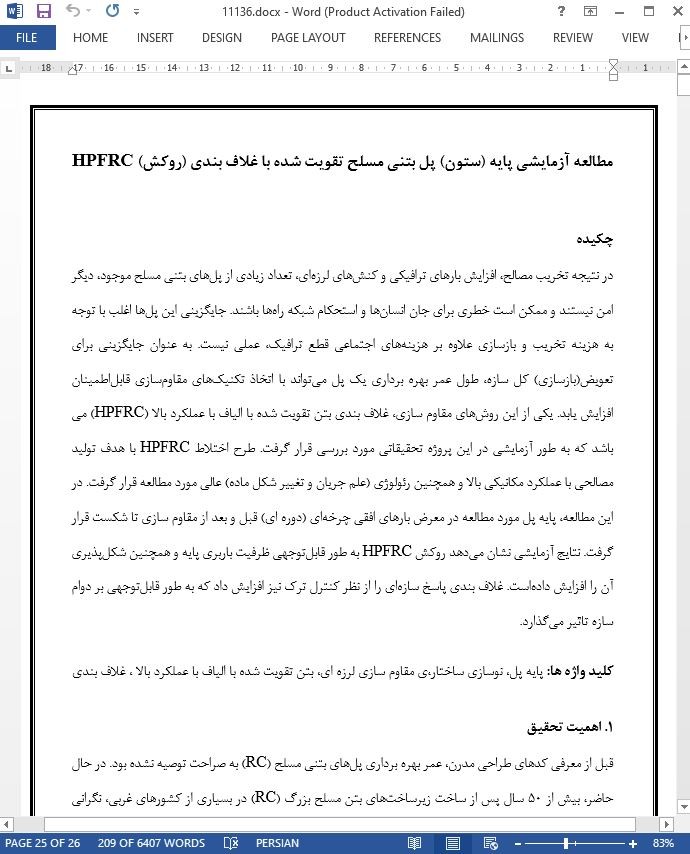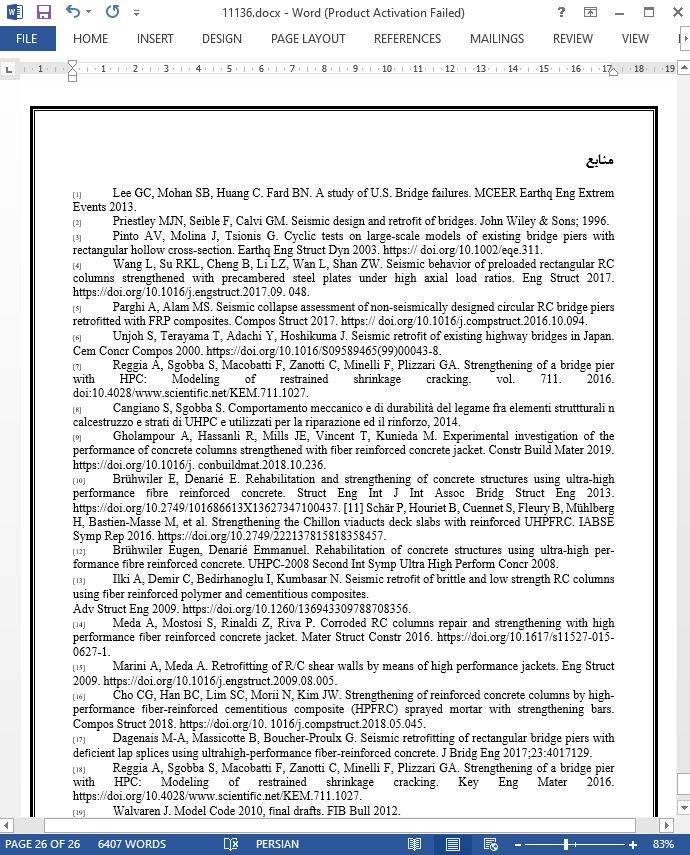
مطالعه آزمایشی پایه (ستون) پل بتنی مسلح تقویت شده با غلاف بندی (روکش) HPFRC
چکیده
در نتیجه تخریب مصالح، افزایش بارهای ترافیکی و کنش¬های لرزهای، تعداد زیادی از پلهای بتنی مسلح موجود، دیگر امن نیستند و ممکن است خطری برای جان انسانها و استحکام شبکه راهها باشند. جایگزینی این پلها اغلب با توجه به هزینه تخریب و بازسازی علاوه بر هزینههای اجتماعی قطع ترافیک، عملی نیست. به عنوان جایگزینی برای تعویض(بازسازی) کل سازه، طول عمر بهره برداری یک پل میتواند با اتخاذ تکنیکهای مقاومسازی قابلاطمینان افزایش یابد. یکی از این روشهای مقاوم سازی، غلاف بندی بتن تقویت شده با الیاف با عملکرد بالا (HPFRC) می باشد که به طور آزمایشی در این پروژه تحقیقاتی مورد بررسی قرار گرفت. طرح اختلاط HPFRC با هدف تولید مصالحی با عملکرد مکانیکی بالا و همچنین رئولوژی (علم جریان و تغییر شکل ماده) عالی مورد مطالعه قرار گرفت. در این مطالعه، پایه پل مورد مطالعه در معرض بارهای افقی چرخهای (دوره ای) قبل و بعد از مقاوم سازی تا شکست قرار گرفت. نتایج آزمایشی نشان میدهد روکش HPFRC به طور قابلتوجهی ظرفیت باربری پایه و همچنین شکلپذیری آن را افزایش دادهاست. غلاف بندی پاسخ سازهای را از نظر کنترل ترک نیز افزایش داد که به طور قابلتوجهی بر دوام سازه تاثیر میگذارد.
۱. اهمیت تحقیق
قبل از معرفی کدهای طراحی مدرن، عمر بهره برداری پلهای بتنی مسلح (RC) به صراحت توصیه نشده بود. در حال حاضر، بیش از ۵۰ سال پس از ساخت زیرساختهای بتن مسلح بزرگ (RC) در بسیاری از کشورهای غربی، نگرانی عمدهای در سراسر جهان در مورد ایمنی و باقی مانده عمر بهره برداری آنها به دلیل تخریب مصالح، افزایش بارهای ترافیکی و خطر زمینلرزه وجود دارد. ظرفیت باربری و تغییر شکل یک پل RC را می توان با استفاده از روشهای مختلف مقاومسازی افزایش داد. یکی از این تکنیکها، غلاف بندی بتن تقویت شده با الیاف با عملکرد بالا (HPFRC) است که مقاومت بهبود یافته در برابر اثرات زیستمحیطی را فراهم میکند و در نتیجه عمر بهره برداری زیرساخت را افزایش میدهد.
6. اظهارات پایانی
براساس مطالعه آزمایشی ارائهشده در اینجا، نتایج زیر را می توان به دست آورد:
1. کارایی روکش HPFRC به عنوان مقاومسازی لرزهای پایه پل به صورت آزمایشی نشانداده شدهاست. این روکش مبتنی بر یک لایه ۳۰ میلیمتری خودمتراکم HPFRC اعمالشده بر روی پایه موجود ماسه پاشی شده بود؛ افزودن آرماتورهای طولی فولادی امکان اتصال بهتر روکش به پی را فراهم کرد.
2. اگر چه یک لایه بسیار نازک روکش اعمال شد، ظرفیت خمشی نمونه تقویتشده با توجه به نمونه تقویت نشده، بیش از ۵۰ درصد افزایش یافت. شکست پایه مقاومسازی شده پس از تسلیم آرماتورهای اضافی با جابجاییهای قابلتوجه، مطابق با دریفت ۳.۴ درصد حاصل شد. با این حال، جزئیات بهتر قسمت پایین ستون، با برخی میلگردهای محصور کننده، ظرفیت باربری اضافی و شکلپذیری المان را فراهم میکند.
3. سختی جانبی نمونه تقویتشده با توجه به پاسخ الاستیک المان تقویت نشده، حدود ۵۰ درصد افزایش یافت.
۴. یک الگوی ترک پخششده با ترکهای بسیار کوچک (کوچکتر از ۰.۲ میلی متر در دریفت ۱ درصد) بر روی سطح روکش HPFRC مشاهده شد.
۵. انتظار میرود که دهانه ترک کوچکتر، علاوه بر تخلخل بسیار پایین ماتریس بتن، به طور قابلتوجهی دوام سازه موجود را افزایش دهد در نتیجه عمر بهره برداری جدید و طولانی تری را فراهم میکند.
Abstract
As a consequence of material degradation, increasing traffic loads and seismic actions, a large number of existing reinforced concrete bridges are no longer safe and may represent a risk for human lives and for the robustness of the road network. Replacement of these bridges is often not practical given the cost of demolition and rebuilding in addition to the social costs of traffic interruption. As an alternative to the replacement of the entire structure, the service life of a bridge can be extended by adopting reliable strengthening techniques. Among these strengthening techniques is High Performance Fibre Reinforced Concrete (HPFRC) jacketing, which was experimentally investigated in this research project. The mix design of HPFRC was studied with the goal of producing a material with enhanced mechanical performance as well as excellent rheology. In this study, the bridge pier studied was subjected to cyclic horizontal loads both before and after strengthening, up to failure. Experimental results show that the HPFRC jacketing remarkably increased the bearing capacity of the pier as well as its ductility. The jacketing also enhanced the structural response in terms of crack control, which significantly governs the structural durability.
2. Introduction
Over the next few years, the number of Reinforced Concrete (RC) road infrastructures requiring repair or strengthening will rise in many Western countries since most of these infrastructures were built between the 50′s and 70′s in a completely different context in terms of traffic expectations and building codes. During the last 50 years, the number of vehicles and the traffic loads have significantly increased; in addition, seismic regulations were introduced in structural codes and have been continuously updated. Furthermore, exposure to aggressive environments for several years has caused material degradation. For these reasons, there is an extreme need to verify and to restore the structural safety of road infrastructures and, especially, of bridges [1]. In Italy, the recent collapses of the “Annone” overpass, completed in 1962 in Annone Brianza, and the “Polcevera” Viaduct (i.e. “Morandi” Bridge), completed in 1967 in Genoa, are catastrophic examples of this need.
6. Concluding remarks
Based on the experimental study herein presented, the following conclusions can be drawn:
1. The effectiveness of a HPFRC jacketing as seismic retrofitting of a bridge pier was experimentally demonstrated. The jacketing was based on a 30 mm layer of self-compacting HPFRC applied on a sand-blasted existing pier; the addition of longitudinal steel reinforcements allowed a better connection of the jacketing to the foundation.
2. Although a very thin layer of jacketing was applied, the flexural capacity of the strengthened specimen increased more than 50% with respect to the un-strengthened specimen. Failure of the retrofitted pier was reached after yielding of the additional reinforcement with appreciable displacements, corresponding to a drift of 3.4%. However, a better detailing of the base section, with some confining rebars, would have provided additional bearing capacity and ductility to the element.
3. Lateral stiffness of the strengthened specimen was increased by approximately 50% with respect to the elastic response of the unstrengthened element.
4. A diffused crack pattern with very small cracks (smaller than 0.2 mm at 1% drift) was observed on the surface of HPFRC jacketing.
5. The smaller crack opening, in addition to the very low porosity of the concrete matrix, are expected to significantly enhance the durability of the existing structure, thus providing a new and longer service life.
چکیده
۱. اهمیت تحقیق
۲. مقدمه
۳. مطالعه موردی
۴. بررسی آزمایشی
4.1. طراحی مقاوم سازی پایه پل موجود
۴.۲. توصیف نمونه
3.۴. خواص مواد
۴.۴. برنامه آزمایشی
۴.۵. راهاندازی تست
۴.۶. پروتکل بارگذاری
۴.۷. ابزار
۵. نتایج آزمایشی
5.1. نمونه تقویتنشده
5.2. نمونه تقویت شده
۵.۳. ترک خوردگی و شکست
۵.۴. مقایسه بین پاسخ قبل و بعد از غلاف بندی
6. اظهارات پایانی
ABSTRACT
1. Research significance
2. Introduction
3. Case study
4. Experimental investigation
4.1. Strengthening design of the existing bridge pier
4.2. Specimen description
4.3. Materials properties
4.4. Experimental program
4.5. Test setup
4.6. Loading protocol
4.7. Instrumentation
5. Experimental results
5.1. Un-strengthened specimen
5.2. Strengthened specimen
5.3. Cracking and failure
5.4. Comparison between the response before and after jacketing
6. Concluding remarks
- ترجمه فارسی مقاله با فرمت ورد (word) با قابلیت ویرایش، بدون آرم سایت ای ترجمه
- ترجمه فارسی مقاله با فرمت pdf، بدون آرم سایت ای ترجمه



